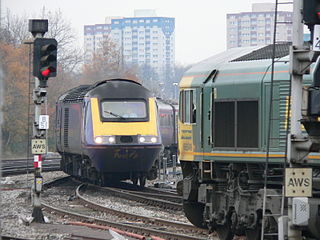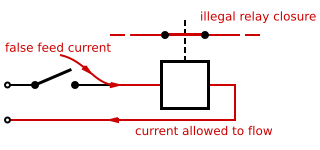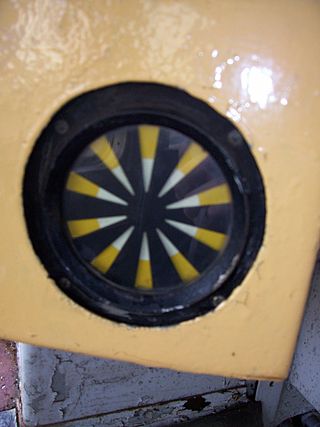
Railway signalling (BE), also called railroad signaling (AE), is a system used to control the movement of railway traffic. Trains move on fixed rails, making them uniquely susceptible to collision. This susceptibility is exacerbated by the enormous weight and inertia of a train, which makes it difficult to quickly stop when encountering an obstacle. In the UK, the Regulation of Railways Act 1889 introduced a series of requirements on matters such as the implementation of interlocked block signalling and other safety measures as a direct result of the Armagh rail disaster in that year.

A signal passed at danger (SPAD), known in the United States as a stop signal overrun and in Canada as passing a stop signal, is an event on a railway where a train passes a stop signal without authority. In the United States and Canada, this may be known colloquially as running a red, though this idiom principally refers to automobiles passing red traffic signals.

Double switching, double cutting, or double breaking is the practice of using a multipole switch to close or open both the positive and negative sides of a DC electrical circuit, or both the hot and neutral sides of an AC circuit. This technique is used to prevent shock hazard in electric devices connected with unpolarised AC power plugs and sockets. Double switching is a crucial safety engineering practice in railway signalling, wherein it is used to ensure that a single false feed of current to a relay is unlikely to cause a wrong-side failure. It is an example of using redundancy to increase safety and reduce the likelihood of failure, analogous to double insulation. Double switching increases the cost and complexity of systems in which it is employed, for example by extra relay contacts and extra relays, so the technique is applied selectively where it can provide a cost-effective safety improvement.

The Clapham Junction rail crash occurred on the morning of 12 December 1988, when a crowded British Rail passenger train crashed into the rear of another train that had stopped at a signal just south of Clapham Junction railway station in London, England, and subsequently sideswiped an empty train travelling in the opposite direction. A total of 35 people died in the collision, while 484 were injured.

The Automatic Warning System (AWS) provides a train driver with an audible indication of whether the next signal they are approaching is clear or at caution. Depending on the upcoming signal state, the AWS will either produce a 'horn' sound, or a 'bell' sound. If the train driver fails to acknowledge a warning indication, an emergency brake application is initiated by the AWS. However if the driver correctly acknowledges the warning indication by pressing an acknowledgement button, then a visual 'sunflower' is displayed to the driver, as a reminder of the warning.

Part of a railway signalling system, a train stop, trip stop or tripcock is a train protection device that automatically stops a train if it attempts to pass a signal when the signal aspect and operating rules prohibit such movement, or if it attempts to pass at an excessive speed.

The Glenbrook rail accident occurred on 2 December 1999 at 8:22 am on a curve east of Glenbrook railway station on the CityRail network between Glenbrook and Lapstone, in the Blue Mountains of New South Wales, Australia. Seven passengers were killed and 51 passengers were taken to hospital with injuries when a CityRail electric interurban train collided with the rear wagon of the long-haul Perth-to-Sydney Indian Pacific.
The Cowan rail accident occurred at 7:20pm on 6 May 1990 when the 3801 Limited special steam passenger train returning from the Morpeth Jazz Festival was struck in the rear by the following CityRail inter-urban passenger service. The steam train had stalled while attempting to climb the steep gradient from the Hawkesbury River to Cowan, New South Wales, and it was found that sand applied to the rails to regain traction had interfered with the signals and given the following train a false clear indication.
The Norton Fitzwarren rail crash occurred on 4 November 1940 between Taunton and Norton Fitzwarren in the English county of Somerset, when the driver of a train misunderstood the signalling and track layout, causing him to drive the train through a set of points and off the rails at approximately 40 miles per hour (64 km/h). 27 people were killed. The locomotive involved was GWR King Class GWR 6028 King Class King George VI which was subsequently repaired and returned to service. A previous significant accident occurred here on 10 November 1890 and the Taunton train fire of 1978 was also within 2 metres.

The Sydenham rail disaster occurred on 19 December 1953 when a New South Wales Government Railways electric passenger train travelling to Bankstown ran into the rear of another electric train travelling to East Hills at Sydenham.

A track circuit is an electrical device used to prove the absence of a train on rail tracks to signallers and control relevant signals. An alternative to track circuits are axle counters.
Australian railway signalling varies between the States of Australia, because the individual States are responsible for the railway systems within their own borders, with, historically, no need to co-ordinate between states except at the boundaries.

The Spa Road Junction rail crash was an accident on the British railway system which occurred during the peak evening rush hour of 8 January 1999 at Spa Road Junction in Bermondsey, in South East London.
The Barnes rail crash, in which 13 people were killed and 41 were injured, occurred at Barnes railway station late in the evening of Friday 2 December 1955.
The railways of New South Wales, Australia have had many incidents and accidents since their formation in 1831. There are close to 1000 names associated with rail-related deaths in NSW on the walls of the Australian Railway Monument in Werris Creek. Those killed were all employees of various NSW railways. The details below include deaths of employees and the general public.
The Charing Cross tube crash occurred at 08:32 hours on 10 March 1938, when a Northern line train ran into the rear of a stationary train near Charing Cross in London. Twelve people were slightly injured. The accident was caused by a signal technician carrying out a temporary repair to a faulty signal even though he was not familiar with the layout and did not have access to the signalling diagram.
A slide fence is a structural fence designed to physically stop falling rocks from reaching the tracks. The fence is designed to retain a rockslide if possible, but if it is displaced by such it also can cause the signaling system to display a restrictive aspect to approaching trains.
The Wrawby Junction rail crash was a train crash which occurred on 9 December 1983, at Wrawby Junction, near Barnetby station, North Lincolnshire, England.
The Charing Cross tube crash occurred on 17 May 1938 at about 09:55 hours, between Charing Cross and Temple stations. Six people were killed when a Circle line service ran into the rear of a District line service held at an automatic signal. A wiring error had caused the preceding signal to incorrectly display a green aspect.
The Marden rail crash occurred on 4 January 1969 near Marden, Kent, United Kingdom, when a passenger train ran into the rear of a parcels train, having passed two signals at danger. Four people were killed and 11 were injured. One person was awarded the British Empire Medal for his part in the aftermath of the collision.









